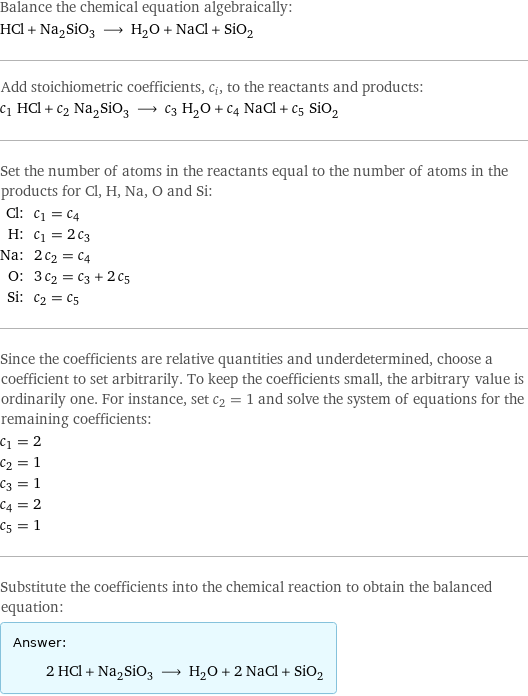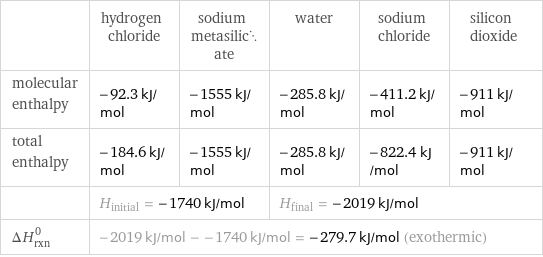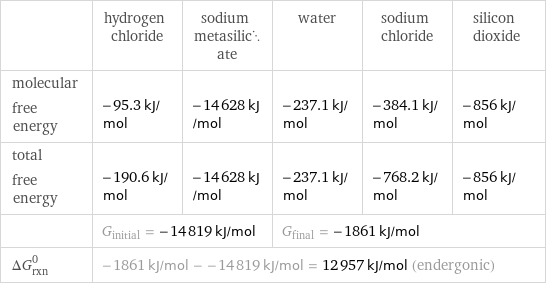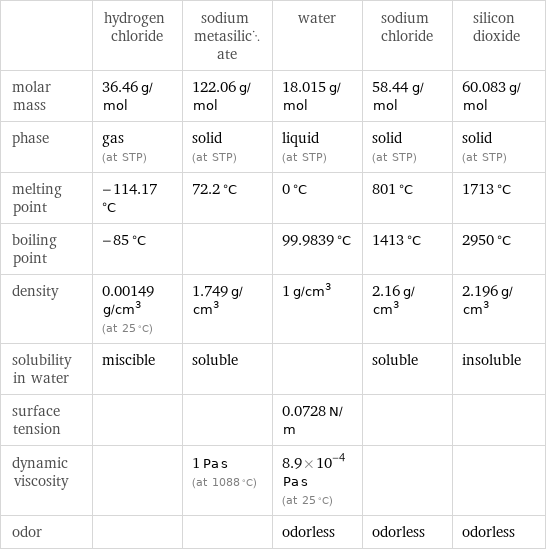Input interpretation

HCl hydrogen chloride + Na_2SiO_3 sodium metasilicate ⟶ H_2O water + NaCl sodium chloride + SiO_2 silicon dioxide
Balanced equation

Balance the chemical equation algebraically: HCl + Na_2SiO_3 ⟶ H_2O + NaCl + SiO_2 Add stoichiometric coefficients, c_i, to the reactants and products: c_1 HCl + c_2 Na_2SiO_3 ⟶ c_3 H_2O + c_4 NaCl + c_5 SiO_2 Set the number of atoms in the reactants equal to the number of atoms in the products for Cl, H, Na, O and Si: Cl: | c_1 = c_4 H: | c_1 = 2 c_3 Na: | 2 c_2 = c_4 O: | 3 c_2 = c_3 + 2 c_5 Si: | c_2 = c_5 Since the coefficients are relative quantities and underdetermined, choose a coefficient to set arbitrarily. To keep the coefficients small, the arbitrary value is ordinarily one. For instance, set c_2 = 1 and solve the system of equations for the remaining coefficients: c_1 = 2 c_2 = 1 c_3 = 1 c_4 = 2 c_5 = 1 Substitute the coefficients into the chemical reaction to obtain the balanced equation: Answer: | | 2 HCl + Na_2SiO_3 ⟶ H_2O + 2 NaCl + SiO_2
Structures

+ ⟶ + +
Names

hydrogen chloride + sodium metasilicate ⟶ water + sodium chloride + silicon dioxide
Reaction thermodynamics
Enthalpy

| hydrogen chloride | sodium metasilicate | water | sodium chloride | silicon dioxide molecular enthalpy | -92.3 kJ/mol | -1555 kJ/mol | -285.8 kJ/mol | -411.2 kJ/mol | -911 kJ/mol total enthalpy | -184.6 kJ/mol | -1555 kJ/mol | -285.8 kJ/mol | -822.4 kJ/mol | -911 kJ/mol | H_initial = -1740 kJ/mol | | H_final = -2019 kJ/mol | | ΔH_rxn^0 | -2019 kJ/mol - -1740 kJ/mol = -279.7 kJ/mol (exothermic) | | | |
Gibbs free energy

| hydrogen chloride | sodium metasilicate | water | sodium chloride | silicon dioxide molecular free energy | -95.3 kJ/mol | -14628 kJ/mol | -237.1 kJ/mol | -384.1 kJ/mol | -856 kJ/mol total free energy | -190.6 kJ/mol | -14628 kJ/mol | -237.1 kJ/mol | -768.2 kJ/mol | -856 kJ/mol | G_initial = -14819 kJ/mol | | G_final = -1861 kJ/mol | | ΔG_rxn^0 | -1861 kJ/mol - -14819 kJ/mol = 12957 kJ/mol (endergonic) | | | |
Equilibrium constant
![Construct the equilibrium constant, K, expression for: HCl + Na_2SiO_3 ⟶ H_2O + NaCl + SiO_2 Plan: • Balance the chemical equation. • Determine the stoichiometric numbers. • Assemble the activity expression for each chemical species. • Use the activity expressions to build the equilibrium constant expression. Write the balanced chemical equation: 2 HCl + Na_2SiO_3 ⟶ H_2O + 2 NaCl + SiO_2 Assign stoichiometric numbers, ν_i, using the stoichiometric coefficients, c_i, from the balanced chemical equation in the following manner: ν_i = -c_i for reactants and ν_i = c_i for products: chemical species | c_i | ν_i HCl | 2 | -2 Na_2SiO_3 | 1 | -1 H_2O | 1 | 1 NaCl | 2 | 2 SiO_2 | 1 | 1 Assemble the activity expressions accounting for the state of matter and ν_i: chemical species | c_i | ν_i | activity expression HCl | 2 | -2 | ([HCl])^(-2) Na_2SiO_3 | 1 | -1 | ([Na2SiO3])^(-1) H_2O | 1 | 1 | [H2O] NaCl | 2 | 2 | ([NaCl])^2 SiO_2 | 1 | 1 | [SiO2] The equilibrium constant symbol in the concentration basis is: K_c Mulitply the activity expressions to arrive at the K_c expression: Answer: | | K_c = ([HCl])^(-2) ([Na2SiO3])^(-1) [H2O] ([NaCl])^2 [SiO2] = ([H2O] ([NaCl])^2 [SiO2])/(([HCl])^2 [Na2SiO3])](../image_source/72e2c7ba6f7301fa207d2cf4a33223b2.png)
Construct the equilibrium constant, K, expression for: HCl + Na_2SiO_3 ⟶ H_2O + NaCl + SiO_2 Plan: • Balance the chemical equation. • Determine the stoichiometric numbers. • Assemble the activity expression for each chemical species. • Use the activity expressions to build the equilibrium constant expression. Write the balanced chemical equation: 2 HCl + Na_2SiO_3 ⟶ H_2O + 2 NaCl + SiO_2 Assign stoichiometric numbers, ν_i, using the stoichiometric coefficients, c_i, from the balanced chemical equation in the following manner: ν_i = -c_i for reactants and ν_i = c_i for products: chemical species | c_i | ν_i HCl | 2 | -2 Na_2SiO_3 | 1 | -1 H_2O | 1 | 1 NaCl | 2 | 2 SiO_2 | 1 | 1 Assemble the activity expressions accounting for the state of matter and ν_i: chemical species | c_i | ν_i | activity expression HCl | 2 | -2 | ([HCl])^(-2) Na_2SiO_3 | 1 | -1 | ([Na2SiO3])^(-1) H_2O | 1 | 1 | [H2O] NaCl | 2 | 2 | ([NaCl])^2 SiO_2 | 1 | 1 | [SiO2] The equilibrium constant symbol in the concentration basis is: K_c Mulitply the activity expressions to arrive at the K_c expression: Answer: | | K_c = ([HCl])^(-2) ([Na2SiO3])^(-1) [H2O] ([NaCl])^2 [SiO2] = ([H2O] ([NaCl])^2 [SiO2])/(([HCl])^2 [Na2SiO3])
Rate of reaction
![Construct the rate of reaction expression for: HCl + Na_2SiO_3 ⟶ H_2O + NaCl + SiO_2 Plan: • Balance the chemical equation. • Determine the stoichiometric numbers. • Assemble the rate term for each chemical species. • Write the rate of reaction expression. Write the balanced chemical equation: 2 HCl + Na_2SiO_3 ⟶ H_2O + 2 NaCl + SiO_2 Assign stoichiometric numbers, ν_i, using the stoichiometric coefficients, c_i, from the balanced chemical equation in the following manner: ν_i = -c_i for reactants and ν_i = c_i for products: chemical species | c_i | ν_i HCl | 2 | -2 Na_2SiO_3 | 1 | -1 H_2O | 1 | 1 NaCl | 2 | 2 SiO_2 | 1 | 1 The rate term for each chemical species, B_i, is 1/ν_i(Δ[B_i])/(Δt) where [B_i] is the amount concentration and t is time: chemical species | c_i | ν_i | rate term HCl | 2 | -2 | -1/2 (Δ[HCl])/(Δt) Na_2SiO_3 | 1 | -1 | -(Δ[Na2SiO3])/(Δt) H_2O | 1 | 1 | (Δ[H2O])/(Δt) NaCl | 2 | 2 | 1/2 (Δ[NaCl])/(Δt) SiO_2 | 1 | 1 | (Δ[SiO2])/(Δt) (for infinitesimal rate of change, replace Δ with d) Set the rate terms equal to each other to arrive at the rate expression: Answer: | | rate = -1/2 (Δ[HCl])/(Δt) = -(Δ[Na2SiO3])/(Δt) = (Δ[H2O])/(Δt) = 1/2 (Δ[NaCl])/(Δt) = (Δ[SiO2])/(Δt) (assuming constant volume and no accumulation of intermediates or side products)](../image_source/b129edf9e51c058aeddd8ff039a27850.png)
Construct the rate of reaction expression for: HCl + Na_2SiO_3 ⟶ H_2O + NaCl + SiO_2 Plan: • Balance the chemical equation. • Determine the stoichiometric numbers. • Assemble the rate term for each chemical species. • Write the rate of reaction expression. Write the balanced chemical equation: 2 HCl + Na_2SiO_3 ⟶ H_2O + 2 NaCl + SiO_2 Assign stoichiometric numbers, ν_i, using the stoichiometric coefficients, c_i, from the balanced chemical equation in the following manner: ν_i = -c_i for reactants and ν_i = c_i for products: chemical species | c_i | ν_i HCl | 2 | -2 Na_2SiO_3 | 1 | -1 H_2O | 1 | 1 NaCl | 2 | 2 SiO_2 | 1 | 1 The rate term for each chemical species, B_i, is 1/ν_i(Δ[B_i])/(Δt) where [B_i] is the amount concentration and t is time: chemical species | c_i | ν_i | rate term HCl | 2 | -2 | -1/2 (Δ[HCl])/(Δt) Na_2SiO_3 | 1 | -1 | -(Δ[Na2SiO3])/(Δt) H_2O | 1 | 1 | (Δ[H2O])/(Δt) NaCl | 2 | 2 | 1/2 (Δ[NaCl])/(Δt) SiO_2 | 1 | 1 | (Δ[SiO2])/(Δt) (for infinitesimal rate of change, replace Δ with d) Set the rate terms equal to each other to arrive at the rate expression: Answer: | | rate = -1/2 (Δ[HCl])/(Δt) = -(Δ[Na2SiO3])/(Δt) = (Δ[H2O])/(Δt) = 1/2 (Δ[NaCl])/(Δt) = (Δ[SiO2])/(Δt) (assuming constant volume and no accumulation of intermediates or side products)
Chemical names and formulas

| hydrogen chloride | sodium metasilicate | water | sodium chloride | silicon dioxide formula | HCl | Na_2SiO_3 | H_2O | NaCl | SiO_2 Hill formula | ClH | Na_2O_3Si | H_2O | ClNa | O_2Si name | hydrogen chloride | sodium metasilicate | water | sodium chloride | silicon dioxide IUPAC name | hydrogen chloride | disodium dioxido-oxosilane | water | sodium chloride | dioxosilane
Substance properties

| hydrogen chloride | sodium metasilicate | water | sodium chloride | silicon dioxide molar mass | 36.46 g/mol | 122.06 g/mol | 18.015 g/mol | 58.44 g/mol | 60.083 g/mol phase | gas (at STP) | solid (at STP) | liquid (at STP) | solid (at STP) | solid (at STP) melting point | -114.17 °C | 72.2 °C | 0 °C | 801 °C | 1713 °C boiling point | -85 °C | | 99.9839 °C | 1413 °C | 2950 °C density | 0.00149 g/cm^3 (at 25 °C) | 1.749 g/cm^3 | 1 g/cm^3 | 2.16 g/cm^3 | 2.196 g/cm^3 solubility in water | miscible | soluble | | soluble | insoluble surface tension | | | 0.0728 N/m | | dynamic viscosity | | 1 Pa s (at 1088 °C) | 8.9×10^-4 Pa s (at 25 °C) | | odor | | | odorless | odorless | odorless
Units
